Taking part in a freediving competition is a test of mental and bodily strength, as Mallika Naguran finds out at Blue Planet’s annual event in Koh Lanta, Thailand. Gaia Discovery was a proud media partner of the Andaman Freediving Competition.
Koh Lanta, Thailand, 13 Feb 2011. Freedivers are a strange lot. They discard the aqualung, and instead take a huge gulp of air into their lungs, to take them deep down into the ocean to depths of 100 metres - and beyond.
In a competition, freedive athletes are required to complete specified disciplines according to the protocols set by AIDA or Association Internationale pour le Développement de l'Apnée – a broadly accepted federation of breath-hold diving established in 1992.
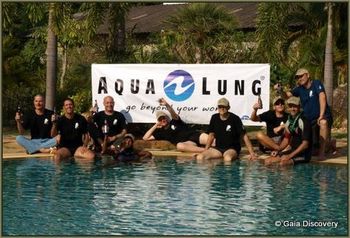
Andaman Freediving Contest 2011 set new personal bests and national records
The association sets safety standards and promotes the education of necessary skills to help divers remain underwater on the intake of one big breath without suffering the risk of black out upon surfacing, or experiencing loss of motor control. Or Samba, as it’s often called.
The Andaman Freediving Championship offers six disciplines in total; three in the pool and three in the ocean, back to back over two days - strenuous, but not impossible.
At the Andaman Freediving Championship held on 10 to 12 February at Koh Lanta – a small island off the Krabi province of Southern Thailand - the freediving athletes were not just in top form but also good humoured. Organising the contest for the fourth year, Blue Planet was pleased with the number of participants and the wide representation with divers arriving from Australia, Sweden, Switzerland, Great Britain and Malaysia.
“We are happy with the eight contestants as it’s a number that’s easy to manage,” says general manager Melissa Bunyan. “Looking at their personal bests, it appears that they have pretty similar performances - this will make this competition interesting.”
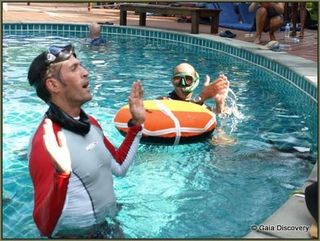
Daniel Palmer falls back in relief after topping Static Apnea points
What goes through freedivers’ minds when they leave the security of freeflow air on land to tackle underwater without any external breathing aid? “I just imagine that I am taking my dog for a walk in the woods,” says Drutten Nygren, one contestant from Sweden (known as Mr D) after coming up to the surface following the Free Immersion (FIM) discipline.
In the FIM discipline, divers grab on to a line and pull themselves along it to reach an intended depth, and back up again. The power in each pull is the only means of propulsion, and divers can opt to descend head down or feet first depending on how they can best equalize in the presence of water pressure.
Next up was Constant Weight (CWT), where divers use their body weight to descend and ascend with the use of a pair of fins or the mermaid-like monofin. In this category, Azam Mohd Hamid set a new national record for Malaysia at 32m. Azam, a 36-year-old pilot with Malaysian Airlines, had only learnt this sport a year before, taking up pool dives in Kuala Lumpur and completing ocean dives in Pulau Perhentian. This sport is just picking up in Malaysia, making Azam a pioneering freediver among the handful of breath-holding dive community.
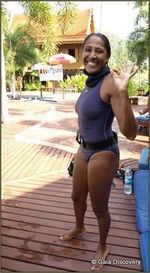
Mauritian-British Marie Cartwright loves the challenge of freediving.
It was a memorable trip for Marie Cartwright, a 34-year-old Mauritius-born woman who now lives in England. The corporate lawyer and former national Mauritian sprinter had taken up freediving just over a year ago, and she did well, coming in sixth place overall out of eight. Marie had managed to scrape through with a white card (perfect pass) for the CWT category but yellow cards for the FIM and Constant Weight Without Fins (CNF) discipline.
Yellow cards are given out to contestants who managed to complete the discipline but not entirely according to procedures, hence are knocked down by some penalty points. As in any competition there were moments of contention. With the safety lanyard coming loose during the ascent of the CNF discipline, both Marie and Daniel Palmer surfaced to find themselves penalized by the AIDA judges. Apparently, they had relied on a borrowed lanyard instead of using their own and had asked a judge to secure it while preparing for their turn in the ocean. This is not the norm; contestants are required to have their own safety lanyard and gear up by themselves. The judge merely did them a favour.
Now because the lanyard had come loose upon their ascent, this presented a grey area on who could have been responsible for the error. Marie, overwhelmed by what she thought was unfair, sobbed. Daniel shrugged.
After holding a consultation among themselves, the judges agreed that indeed there was an uncertainty with the lanyard coming loose on those two competitors while it stayed fast on others. They then overturned their earlier decision of awarding the divers yellow cards, to white ones, much to the applause of other contestants, safety divers and supporters on the boat.
Judges at this event were Andreas Falkenroth, AIDA Instructor Trainer; AIDA master instructor Richard Wonka and AIDA instructor Sarah Whitcher. All three are based in Phuket. AIDA instructor Mark Guerrin who works with Blue Planet on Koh Lanta provided the safety support during the competition.
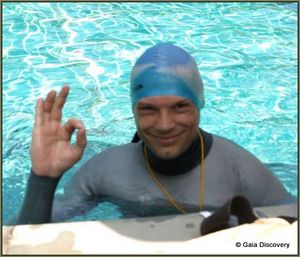
Gregoire Folly triumphed over others to win the Andaman Freediving Championship 2011
Gregoire Folly, 38, from Switzerland was the star of the event, and the overall champion. The 1.93m chemist had trained for one and half years first in Koh Lanta with Mark Guerrin of Blue Planet, and then in Switzerland. Greg, now an assistant instructor in freediving, aced the first three disciplines in the ocean – three demanding activities that are not often held back to back in a single day in international competitions. “I am just motivated,” he said modestly of his remarkable achievements.
The pool sessions were held the next day at the Royal Lanta Resort and Spa. In general the contestants performed below par in the Static Apnea (STA) discipline possibly due to exhaustion from the previous day’s ocean competition, plus the heat from the scorching sun.
The athletic spirit was high though. Daniel Palmer edged over the rest by holding his breath for 5 minutes and 15 seconds. The event did not progress without any drama. John Lambert nearly blacked out underwater from holding his breath for nearly five minutes, and had to be yanked out where he quickly recovered. “I couldn’t tell I was going through a blackout,” he told me later, describing a state of mind where he was subconscious all the time through the rescue effort yet had no control of his body.
Another Australian competitor, Michael Baldwin, also learnt his body’s limitations when attempting Dynamic With Fins (DYN). He bettered his announced distance of 125m to swim all of 144m on a single breath, however he failed to display the right protocol as he briefly experienced loss of motor control. He was flashed a red card, which meant disqualification.
Explaining his performance, Michael said that he could easily achieve that distance doing the laps back home in Cairns. What he and the other contestants didn’t quite realise was when competing with several disciplines in a day, fatigue takes a toll on the body. “We often think mind over matter, however matter matters,” quipped John.
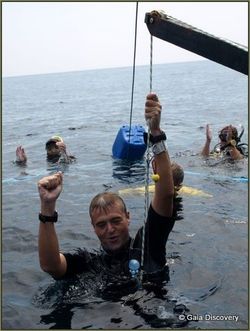
James Valentine bettered his own performance all round.
Swedish Mr D aced the Dynamic Without Fins (DNF) session with a distance of 93m. As the last contender at the end of the competition, he was promptly rewarded with a chilled Tiger to the rousing applause of supporters!
Surprisingly, several of the contestants had only mastered the skills of freediving a year before. Champ Gregoire had less than two years’ experience, but had been actively pursuing the sport since he first took it up. A few of the freedivers in fact had ditched scuba diving after tasting the freedom involved in diving the deep without rigging up burdensome and bulky scuba gear.
Melissa told me that freediving looks harder than what it is, with most new learners chalking 16m depth easily at the first few go. “You don’t have to be super fit like William Trubridge in order to take up this sport,” she laughed, referring to the Australian world record holder of deep ocean dives who she clearly has a soft spot for.
“Come and join us next year,” she tells Gaia Discovery readers. “It’ll be held in the same period 10-12 Feb, but it will be bigger. There will be a day of training and briefing in between the ocean and pool sessions so it will be easier on athletes,” she said, adding that participants can also benefit from free training from instructor Mark Guerrin prior to the event. Contestants paid 5,000 Thai baht this year for the competition, which included free training in the pool and ocean (with boat hire). Sponsored prizes came from Aqualung (wetsuits, micromasks), Suunto (D4) and complimentary stays at the Royal Lanta Resort & Spa.
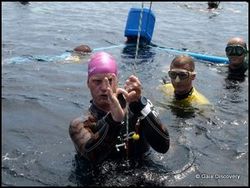
Mr D, or Drutten Nygren, loves action and attention!
“The prizes are great!” commented an overwhelmed Gregoire who could barely hold his multiple prizes. “I’m just used to receiving tee shirts as a reward for freediving competitions in Europe.”
If you are thinking of taking up freediving, do not hesitate. It is fun, a lot easier than it looks, and can be rewarding in more ways than one.
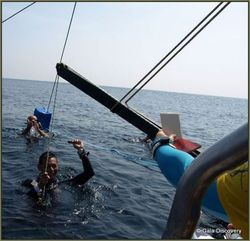
Azam Hamid makes Malaysia proud with four new national records.
Overall Results:
1st – Gregoire Folly (Switzerland)
2nd – James Valentine (Great Britain)
3rd - Drutten Nygren (Sweden)
4th - Daniel Palmer (British)
5th - Michael Baldwin (Australia)
6th - Marie Cartwright (Great Britain)
7th - Azam Mohd Hamid (Malaysia), also set 4 new national records
8th - John Lambert (Australia)
Photography by Mallika Naguran
Visit Blue Planet to sign up for freediving training and/or to participate in next year’s championship 10-12 February 2012 at Koh Lanta. Or email Melissa Bunyan at blueplanetdivers@gmail.com.
Read 2012 Andaman Freediving competition review by participant Walter Johnson.